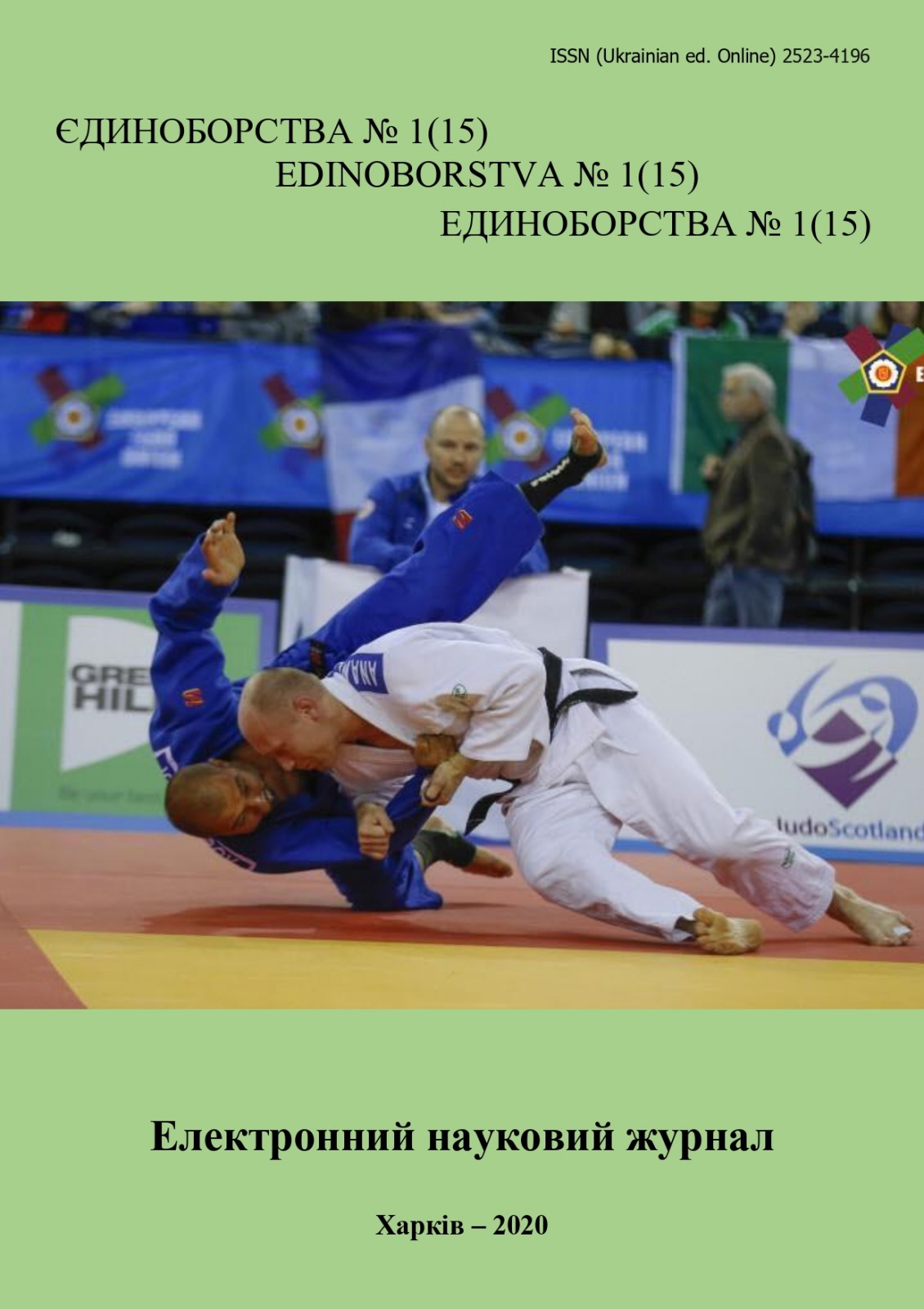Development of balance using balance exercises on fitballs
DOI:
https://doi.org/10.15391/ed.2020-1.08Keywords:
development of equilibrium, matchball, balance, expert estimates, research, statistically significantAbstract
Purpose: developing equilibrium in judo players 9-11 years old with the help of the right to balance on fitball. Material and methods. During pedagogical research, the method of expert assessments was used. At a 5-point scale, experts evaluated the spatial orientation of athletes. The age of the studied athletes is 9-11 years. Research methods: theoretical analysis and generalization of literary sources, pedagogical observations, expert assessment method, methods of mathematical statistics. Results: all athletes were divided into control (n=15) and experimental (n=15) groups. A feature of the educational process in the experimental group was the use of special exercises on fitballs aimed at developing dynamic balance in judokas. Experts evaluated the fidelity of such indicators of equilibrium: the work and position of the arms, legs and torso. Considering the results of the method of expert evaluations among judoists of the experimental group at the beginning and at the end of the study, we can say that the average score for the indicators increased significantly and the growth was significant (<0,05). When performing the Romberg test test, the experimental group had a significant advantage over the control group, they were statistically significant (t=11,3; p>0,05) while in the control group the increase was (t=3,75; p>0,05). The analysis showed that the indicators of the athletes of the control group have a positive dynamics but not as pronounced as that of the athletes of the experimental group and, accordingly, statistically significant changes in only the balance content with the help of hands. Obviously, the group that used the presented exercises on balancing on fitballs to study the balance has significantly better results. Conclusions. Based on the athletes' data obtained at the beginning and the ends of the pedagogical experiment, it can be noted that each judoka in the control and experimental groups experienced an increase in the level of indicators, but among the athletes of the experimental group they are statistically significant. The best growth result among athletes of the experimental group was the performance of the test of the gymnastic exercise «Swallow» (t=18,39; p<0,05) and the test of the Romberg test (t=11,3; p<0,05).
References
Бойченко, Н. В. (2007). Пути повышения эффективности тренировочного процесса в восточных единоборствах. Физическое воспитание студентов творческих специальностей, 2, 148-150.
Бойченко, Н. В., & Чоботько, М. А. (2019). Оптимізація навчання техніки дзюдо за допомогою вправ з фітболом. Єдиноборства, № 3 (13), 13-20.
Болдырева, В. Б., Головков, А. А., & Татаринцев, А. Н. (2013). Развитие координационных способностейюношей 13–14 лет, занимающихся дзюдо. Вестник тамбовского университета. Серия: гуманитарные науки, (7 (123)), 207-210.
Васильков, А. А. (2008). Теория и методика спорта. Феникс, Ростов н/Д.
Григорьева, Е. Л., & Седов, И. А. (2017). Методика воспитания координационных способностей в спортивно-оздоровительных группах отделения дзюдо. Успехи современной науки и образования, 2(4), 203-205.
Козырева, Д. А., Бицадзе, Н. Г., & Варфоломеева, З. С. (2017). Оценка функционального состояния центральной нервной системы и координационных способностей дзюдоистов на начальном этапе спортивного отбора. Международный научно-исследовательский журнал, (08 (62) Часть 1), 77-80.
Никитин, С. Н. (2005). Особенности управления двигательными действиями в спортивной борьбе. Вестник Балтийской педагогической академии, Вып. 62, 61-67.
Расулев, И. А., & Горелик, В. В. (2016). Развитие координационных способностей у детей 10-15 лет с ослабленным соматическим здоровьем средствами єдиноборств. Магистерская диссертация. Тольятти.
Тропин, Ю. Н., & Бойченко, Н. В. (2017). Содержание различных сторон подготовки борцов. Единоборства, 79-83.
Филиппов, М. В. (2013). Особенности координационной подготовки юных дзюдоистов. Международный научно-исследовательский журнал, (6-3 (13)), 51.
Чоботько, М. А. (2018). Особенности методики обучения дзюдоистов-новичков. Проблемы и перспективы развития спортивных игр и единоборств в высших учебных заведениях, 75-79.
Чоботько, М. А., Чертов, І. І., Бойченко, Н. В., Зантарая, Г. М., & Чоботько, І. І. (2019). Застосування вправ з футболом при навчанні техніці кидків в дзюдо. Єдиноборства, № 4 (14), 127-137.
Zhumakulov, Z. P. (2017). Education Technology of Primary Training Sport Wrestling. Eastern European Scientific Journal, 5, 29-35.













